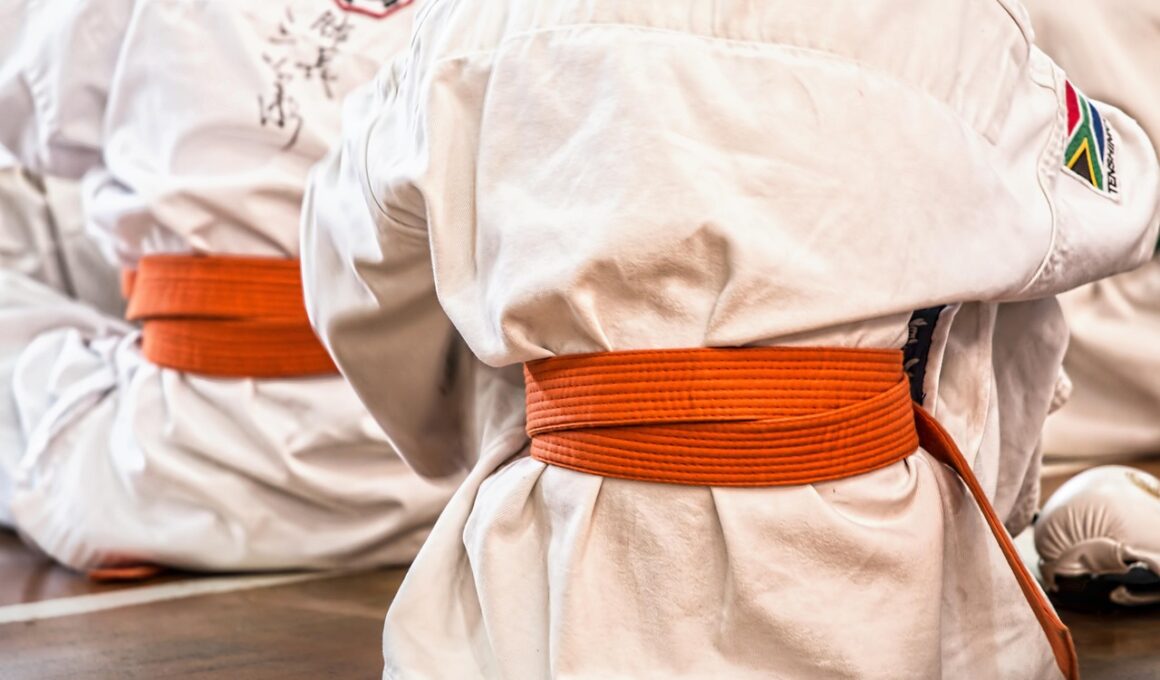The Role of Bodyweight Training in Outdoor Martial Arts
Outdoor martial arts conditioning presents a unique opportunity to enhance physical fitness and mastery of combat techniques. One key component of this training is bodyweight exercises, which serve as an effective foundation for strength and flexibility. These exercises rely solely on the body’s weight, allowing practitioners to improve their fitness without the need for any equipment. Additionally, outdoor settings provide a refreshing environment that enhances the workout experience. By doing martial arts training outside, you can benefit from fresh air and natural surroundings, which can boost your motivation and performance. Utilizing bodyweight training in outdoor settings tallies with the principles of martial arts, instilling discipline and focus. It’s essential to engage in warm-up exercises, ensuring that your muscles are ready for rigorous training sessions. Specific movements, such as push-ups, pull-ups, squats, and lunges not only build essential strength but also prepare the body for complex martial arts moves. Thus, bodyweight training is vital in developing skills necessary for proficient outdoor martial arts performance. These combined elements create a rounded, robust training regime that promotes overall health and martial artistry.
When it comes to creating a well-rounded outdoor martial arts regimen, incorporating bodyweight training has extensive benefits. Strength training is crucial for any martial artist, as increased strength can lead to powerful strikes and effective grappling techniques. Bodyweight exercises emphasize functional strength, which translates directly into martial arts skills. By focusing on movements that mimic combat scenarios, practitioners can enhance their bodily control and coordination. Moreover, bodyweight drills improve muscle endurance, allowing martial artists to sustain their energy during longer sessions. This is especially important in sparring situations where fatigue can lead to mistakes. Besides enhancing physical capabilities, bodyweight training also instills mental toughness. The ability to push through physical discomfort builds resilience, an invaluable trait in martial arts. In outdoor environments, these workouts become more engaging and exciting. For instance, utilizing park benches for tricep dips or inclines for hill sprints can introduce variety and challenge, subsequently improving one’s adaptation to different terrains and conditions. Therefore, integrating bodyweight exercises into outdoor martial art training sessions augments the total experience and maximizes skill development for martial artists.
Benefits of Bodyweight Training
Bodyweight training effectively enhances strength, endurance, and flexibility for martial artists engaged in outdoor workouts. Unlike traditional weightlifting, bodyweight exercises engage multiple muscle groups simultaneously, promoting balanced development. This holistic approach minimizes the risk of injury, as practitioners develop muscle control and stability across their entire body. Additionally, the nature of outdoor workouts allows individuals to train in diverse environments, making training sessions more enjoyable and dynamic. Adjusting to various terrains and weather conditions helps the body adapt and improves overall coordination and strength. Moreover, bodyweight exercises are highly versatile and can be performed virtually anywhere, eliminating barriers to training accessibility. This flexibility supports consistent practice, enabling martial artists to train regardless of location. One advantage of bodyweight training is that it often requires minimal or no equipment, making it cost-effective. Incorporating movements like planks, burpees, and mountain climbers cultivates stamina and functional fitness. Furthermore, practicing these exercises regularly develops a solid core, which is vital for stability in martial arts techniques, including striking and grappling. Thus, the numerous benefits of bodyweight training elevate outdoor martial arts conditioning and foster exceptional physical capabilities.
To maximize the effectiveness of bodyweight training in outdoor martial arts, practitioners need to create a structured workout plan. A well-organized routine incorporates various exercises that target different muscle groups while keeping the training engaging and adaptable. Start with a thorough warm-up, consisting of dynamic stretches and mobility drills to prepare the body for rigorous movements. Then progress into a circuit of bodyweight exercises alternating between upper body, lower body, and core movements. For instance, begin with push-ups, followed by jumping squats, and conclude with planks. This approach not only builds strength but also enhances cardiovascular fitness. To further challenge the body and avoid adaptation, vary the intensity, duration, and number of repetitions regularly. For instance, add more challenging variations, such as one-arm push-ups or pistol squats, to challenge strength alongside core stability. It’s also beneficial to integrate agility drills, like shuttle runs or cone drills, for improved speed, reaction time, and footwork essential in martial arts. By establishing a comprehensive and varied outdoor workout routine, martial artists will maintain enthusiasm, freshness, and physical progression.
Safety Precautions
Ensuring safety should be a priority when engaging in outdoor martial arts training, particularly when incorporating bodyweight exercises. Various outdoor factors could potentially lead to injuries if not carefully navigated. For example, uneven ground surfaces may pose a hazard during dynamic movements, so it’s crucial to assess training environments before beginning workouts. Additionally, proper footwear is essential when training outside to support the feet and ankles effectively. Choose shoes that provide grip and stability, especially when performing exercises such as jumps or sprints on grassy or rocky surfaces. Staying hydrated during training is another crucial aspect. Outdoor workouts can lead to higher perspiration rates, potentially resulting in dehydration. Thus, always carry water, especially on hot sunny days. Moreover, being mindful of the weather conditions is vital for injury prevention. Extreme heat or wet conditions may compromise workout effectiveness and increase slip hazards. To mitigate these risks, integrate rest periods and listen to your body’s signals. If fatigue sets in, it’s advisable to pause or modify the workout. By implementing these safety precautions, martial artists can ensure their outdoor conditioning sessions are productive and enjoyable, while minimizing injury likelihood.
In addition to developing physical strength, outdoor martial arts conditioning enriched with bodyweight training enhances mental clarity and focus important for martial practitioners. The open environment offers a refreshing contrast to indoor training facilities, stimulating creativity and motivation. Engaging in bodyweight exercises amidst nature can elevate mood and reduce stress, thereby enhancing concentration levels. Working out outdoors provides a unique context for practicing mindfulness, as being present in your workouts can significantly improve overall mental performance in martial arts. Furthermore, as practitioners challenge themselves physically, they cultivate self-discipline and determination, vital skills within martial arts culture. Outdoor conditioning can also promote camaraderie if training with partners; this social aspect fuels friendly competition, encouraging participants to push each other further. Additionally, a diverse range of locations leads to unique settings for collaboration, such as a beach, park, or forest, which breaks routine monotony. Encouraging flexible training environments sparks motivation and fosters a deeper love for martial arts. All these elements combine to create a comprehensive, enriching experience, perfect for both mental and physical development, ensuring that martial artists remain engaged while honing their skills in outdoor settings.
Conclusion
In conclusion, bodyweight training plays a pivotal role in enhancing outdoor martial arts conditioning, marrying physical fitness and mental acuity. Its multifaceted approach promotes strength, endurance, and flexibility while fostering mental resilience. Outdoor environments further enrich training experiences, providing motivation and fresh perspectives. Practicing bodyweight exercises introduces versatility, allowing practitioners to remain committed and engaged during workouts. It helps prevent injuries while ensuring all-round functional fitness, suitable for combat situations. Incorporating a balanced, structured routine enhances overall performance and adapts to different environments and weather conditions. Moreover, the social aspects of training with peers can cultivate camaraderie and friendship among martial artists. Keeping safety precautions in mind while training is paramount to avoid injuries and maintain a productive workout experience. Therefore, combining bodyweight training with outdoor martial arts not only empowers practitioners physically but also mentally, reinforcing the values of discipline, focus, and community in martial arts. Moving forward, martial artists should embrace bodyweight exercises in outdoor training, taking advantage of the myriad benefits it brings to their practice.
By finding innovative ways to combine bodyweight training with outdoor martial arts, practitioners will create a transformative experience that nurtures growth and excellence. The fusion of nature and martial arts provides a profound connection to the surrounding elements. Embrace the challenge of outdoor workouts; they enhance your self-awareness and mastery of the art form. Push your limits, savor the freedom of outdoor training, and reap the incredible benefits of bodyweight conditioning in martial arts. Maintain consistency, focus on improvement, and witness the direct impact on your martial arts abilities through outdoor bodyweight training.


